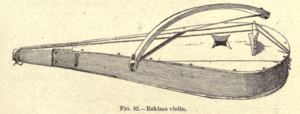Tautirut facts for kids
The tautirut (pronounced "tao-tee-root") is a special musical instrument from the Inuit people of Canada. It's also known as the "Eskimo fiddle." It's a type of zither, which is an instrument where strings are stretched over a flat body. You play the tautirut with a bow, similar to how you play a violin.
What is the Tautirut?
The tautirut is a unique instrument from the Inuit culture. It's often called the "Eskimo violin" because it's played with a bow. The Inuit people live in the Arctic regions of Canada.
How it Looks and Sounds
In 1894, a person named Lucien M. Turner described the "Eskimo violin." He said it was made from wood like birch or spruce. Its two strings were made from strong, twisted animal sinew. The bow used to play it had a piece of whalebone instead of horsehair. People would put sticky spruce gum on the bow to help it grip the strings. When played, the instrument was held across the player's lap.
Later, in 1916, a Canadian expert named Ernest William Hawkes also described the tautirut. He noted it was a simple box with a square hole on top. It had three sinew strings, a bridge to hold the strings up, and a tail-piece. The bow was short and also used whalebone. He added that most Eskimo fiddles usually had only one string.
Where Did the Tautirut Come From?
The tautirut is one of the very few string instruments from First Nations in Canada that might have existed before Christopher Columbus arrived in the Americas. This means it could be a very old instrument!
Some music experts, like Anthony Baines, have noticed that the tautirut looks a lot like other old instruments. These include the Icelandic fiðla and the Shetland gue.
However, another expert named Peter Cooke thought the tautirut was brought to the Inuit people. He believed sailors from the Hudson's Bay Company introduced it. These sailors came from the Orkney and Shetland Islands in Europe. Cooke thought this because the tautirut was mostly found around the Hudson Bay area, which was a common trading spot.


